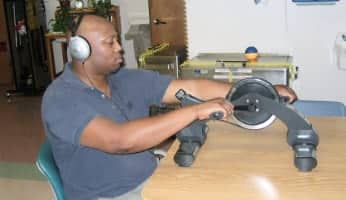One Task at a Time to a Seasoned Multi-Tasker
Home - Testimonials - Adult Testimonials - One Task at a Time to a Seasoned Multi-Tasker
One Task at a Time to a Seasoned Multi-Tasker
Randolph is a successful, 50-year-old professional diagnosed with ADHD.
He felt he could handle any single task efficiently but he would lose focus when he tried to do two tasks simultaneously. For instance, his inability to drive his car and carry on a conversation at the same time.
Interactive Metronome Training
Randolph was hopeful that Interactive Metronome® might help him.
Interactive Metronome® (IM) is the only training program that improves timing in the brain in an organized, systematic, flexible and engaging format. Research shows that combining movement and cognitive tasks leads to better overall outcomes and improvements in language & cognition, stronger motor control & coordination and enhanced balance & gait.
IM is a patented and unique training tool that challenges thinking and movement simultaneously, providing real-time millisecond (ms) feedback to help synchronize the body’s internal clock.
Initial Assessment
An initial IM Pre Long Form Assessment (LFA) was administered, which consists of 14 unique tasks to help Randolph’s therapists assess his coordination of both upper and lower extremities in addition to bilateral integration skills.
He had good natural timing and most of his scores were in the above average and exceptional ranges (12 – 53 ms). He was then given the AttendOver-Time (AOT) assessment and scored 19 ms (superior range), this proved task duration presented no problems.
The normative ranges for IM performance are as follows:| Age | 6 | 7-8 | 9-10 | 11-12 | 13-15 | 16+ |
|---|---|---|---|---|---|---|
| Extreme Deficiency | 280+ | 270+ | 260+ | 240+ | 215+ | 200+ |
| Severe Deficiency | 175-279 | 170-269 | 160-259 | 155-239 | 150-214 | 147-199 |
| Below Average | 120-174 | 90-169 | 80-159 | 75-154 | 72-149 | 70-146 |
| Average | 90-119 | 65-89 | 55-79 | 45-74 | 43-71 | 41-69 |
| Above Average | 56-89 | 56-89 | 38-54 | 36-44 | 33-42 | 30-40 |
| Exceptional | 40-55 | 32-44 | 28-37 | 26-35 | 23-32 | 22-29 |
| Superior | < 40 | < 32 | < 28 | < 26 | < 23 | < 22 |
Accommodations Made to the Training Program
It was expected that Randolph would have normal progression through his IM training but immediately, problems came up, and accommodations were needed.
In his earlier sessions, he was introduced to the visual scores screen (without center flash). The screen’s value as a training aid was explained to him and despite it being designed to help and enhance the task, the screen proved to be a distraction.
In addition to the screen, the guide sounds presented a problem for him and was only able to tolerate the guide sounds when at the lowest volume setting.
Improvements with IM Training
After a few sessions, Randolph was able to tolerate the screen if it was not directly in front of him. Over time he became comfortable with, and was able to utilize, both the visual screen and the guide sounds.
By session 7 he was at ease with a higher volume setting for the guide sounds. His Interim LFA showed continued improvement. His scores (8 – 25 ms) were nearly all in the superior range.
During phase two of IM training, he was taken off the visual screen and the duration of the exercises were extended each time. Randolph made these transitions without difficulty.
In an effort to keep him challenged, new distractions, such as the ceiling fan, were introduced. During session 12, an additional distraction was added; he was allowed to watch a baseball game on TV while completing his IM tasks.
He immediately adapted to the distraction with no change in his scores. Randolph had developed a great capacity to maintain focus and remained hopeful, but in spite of his excellent scores and good attitude he reported no change in his ability to do two things at one time.
As the last three sessions approached, additional challenges were incorporated that would more closely mimic the actual problem with speaking and physical motion. The customized task was to ask him simple questions and require him to answer in complete sentences, (e.g. what color is your car? My car is green) while doing IM. This proved to be difficult for him and his scores did rise.
His treatment plan was modified to include the question/answer tasks using only his hands, which were repeated several times within the hour-long session. During the more difficult IM tasks, Randolph would complete the tasks with no modifications.
On his 14th session, he asked the trainer questions as well, which progressed to holding a “normal conversation”. He was also asked to read articles that were taped on the wall in front of him out loud. This proved to be pretty difficult for him.
Although his scores spiked when each of the three forms of “Talk IM” were introduced he soon caught on and was able to complete “Talk IM” comfortably. Randolph was encouraged to practice physical activity (driving) and talking at the same time for homework. He said it felt very similar to what we had been doing during the recent sessions.
Outcomes
Randolph’s final LFA showed that almost all of his scores had improved since the Interim LFA and were all in the superior range.
At the exit interview, Randolph noted that he was a more focused participant in conversations with his wife and was less likely to be diverted by interruptions. Randolph also reported an unexpected gain; he noted improved anger management/coping skills. Randolph believed he now had the tools to confidently move forward towards his original goal of successfully multi-tasking.
Abbey Timpf, OTR/L
HealthSouth Sunrise Rehabilitation Hospital
Sunrise, FL




